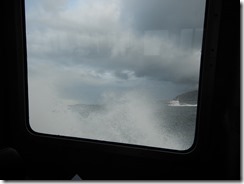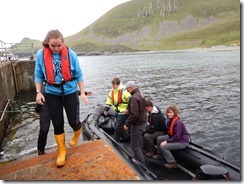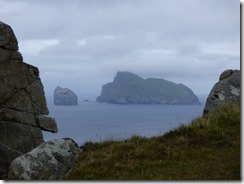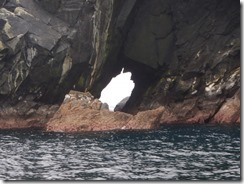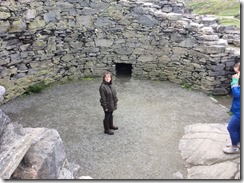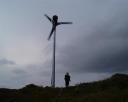It’s 8:45 here at ‘Green Pastures’ https://www.airbnb.co.uk/rooms/26688616 and our host, James Macleod let us have an extra day. Dunno what we’d have done without that right enough for we missed the ferry from Stornoway to Ullapool yesterday. The trusty ‘Egg chariot’ broke down just outside Marybank as we were heading for the 8:00am sailing with plenty of time to spare. Sadly not enough time to repair (once more) the Subaru’s fuel leak. The diving regulator hose I’d used as a temporary repair last week had failed ![]() Luckily I had collected the correct hose and clips on the way to Harris on Tuesday. Sadly I’d been too busy enjoying myself to fit it. Bad mistake cos the car was now fully loaded with the trailer on and a Subaru’s jack is under the boot floor
Luckily I had collected the correct hose and clips on the way to Harris on Tuesday. Sadly I’d been too busy enjoying myself to fit it. Bad mistake cos the car was now fully loaded with the trailer on and a Subaru’s jack is under the boot floor ![]() After getting covered in petrol I managed to sort it and siphoned the fuel out of the boat to replace the stuff deposited on the A859 but by then it was almost 8:00 and the Loch Seaforth would be going without us. Shame, cos I’ve never been on CalMac’s ‘flagship’ https://en.wikipedia.org/wiki/MV_Loch_Seaforth_(2014) and it would be a Raasay man and friend who was Master, so was kinda looking forward to a wee tour
After getting covered in petrol I managed to sort it and siphoned the fuel out of the boat to replace the stuff deposited on the A859 but by then it was almost 8:00 and the Loch Seaforth would be going without us. Shame, cos I’ve never been on CalMac’s ‘flagship’ https://en.wikipedia.org/wiki/MV_Loch_Seaforth_(2014) and it would be a Raasay man and friend who was Master, so was kinda looking forward to a wee tour ![]()

This little episode was a real ‘fly in the ointment’ of what had to date been a brilliant break and had left us stranded on Lewis (on the Sabbath) with little chance of getting off and no chance of reaching Raasay. Sure there was an extra sailing by Seaforth at 15:00 and one from Tarbert by MV Hebrides at 16:20 but these two were fully booked. We may have got on but the only one we could be guaranteed a place on was the 16:20 today from Tarbert.
A trip to the ‘Edge of the World’
So, after managing to contact our Airbnb host James, who was somewhere between here and Brazil we opted to stay another night and ‘chill’. Yesterday’s visit to St Kilda had fair taken it out of us, at 12 hours it’s a full day and most of that is taken up by the journey there and back from Leverburgh.
There are several folk who’ll take you out there, indeed you can charter a RIB from Skye but opted for Angus Campbell’s Kilda Cruises https://www.kildacruises.co.uk/ . Quite simply cos he’s been doing it the longest and his two boats, Hirta and Orca III are the best. Knowing we’d a couple of ‘poor sailors’ in our party we opted for the catamaran Orca III. Cats are generally more stable than monohulled vessels and just look at the size of her accommodation. If folk start throwing up, it can turn even the most seasoned sailors stomach so you want much room as possible between you and your passengers ![]()
With a good Westerly F4/5 ‘on the nose’ it wasn’t the most comfortable ride out and it was forecast to freshen to a F6 at around 15:00. Still the cat handled it well and whilst one or two of the passengers were a little ‘green at the gills’ none were sick and all forgot about it as soon as they set foot on Hirta.
The Hirta is a wee bit faster right enough and gradually overtook us but we dropped off something on the way.
The Hjalmar Bjorge https://www.northernlight-uk.com/our-boats/hjalmar-bjorge/ was anchored in the lee of one of the islands at the mouth of the Sound of Harris awaiting a rucksack or something.
This mustn’t have delayed us by much cos by the time we got to the very sheltered (in a westerly) Village Bay, Hirta still had her passengers aboard. Both vessels have their own moorings to pick up in Village Bay which saves anchoring and time. Passengers then being ferried ashore in an inflatable.
The first thing we came across was a Foden recovery truck a Land Rover and a 4” gun. The truck belonging to the Army the Land Rover to the construction company building more ‘sympathetic’ buildings for them and the gun, well the gun has ‘never fired a shot in anger’. It was placed the ‘after the horse had bolted’ so to speak. During the ‘Great War’ the submarine U90 paid St Kilda a visit.
U-90 had an interesting career. Built in Danzig she was launched in January 1917 after more than a year of construction. Some 66m in length, she carried a compliment of 32 men and 4 officers. Between September and November 1918 she undertook seven patrols, and, in May that year, most famously sank the USS President Lincoln, a former German steamship used as a troop transport. U-90 was surrendered on November 1918 and broken up in Bo’ness on the Firth of Forth.
Our interest here, however, are the activities of U-90 two weeks earlier when she nosed into Village Bay, St Kilda, apparently intent on causing damage. St Kilda had been manned as a Naval wireless station since January 1915 with a group of about 15 men stationed there. With the help of the islanders, the crew manned a series of watching stations on the high hills of the islands, and maintained contact with the outer isles reporting on enemy shipping and actions.
In the early hours of the 15th May she approached St Kilda in order to establish whether it was being used as a military base and radio station. As the U-boat surfaced in the bay and the crew manned the deck gun – some 100 people were seen in the village, many of whom fled to the hills behind. After sounding an audible warning, the crew opened fire on what they took to be a power station and barracks near the shore. Their efforts to bring down the masts proved ineffectual and, due to the presence of some armed men, they elected not to land.
The islanders had rather a different experience. While some did indeed run to the hills, and their cattle became mad with distress, others toyed with the idea of rowing out to bargain for tobacco. Damage was considerable – the islander’s storehouse, church and three of their houses, parts of one of the wireless sets, seven military huts, and the nurse’s house (used as wireless office). Of these it was the late 18th century storehouse that was put out of use permanently. Despite the efforts of the owners to recoup compensation, it remained a ruin until the late 1980s when it was restored by the National Trust for Scotland.
Such a blatant attack, one of only 15 on British shores, caused a strong reaction in the Navy. Two patrol vessels were stationed in the bay and carpenters sent out within a month to enact repairs. With armed trawlers overstretched in the area, it was decided to set up a permanent defence and as early as August 1918 construction began on a gun emplacement and a magazine. Working from 6am to 6pm a group of five builders, assisted by the St Kildans, toiled away for much of the next seven weeks and the gun was announced ready for action on 13th October. Armistice was announced a month later.
A Gun that Never Fired
https://canmore.org.uk/site/214734/st-kilda-hirta-village-bay
Not far from the gun is the ‘feather store’, a substantial building with two storeys, chimneys and a slate roof.
More than can be said for the dwellings of the people of St Kilda, and that’ll be the modernised ones with chimneys ![]() Prior to the mid nineteenth century they lived in ‘black houses’ that didn’t have one.
Prior to the mid nineteenth century they lived in ‘black houses’ that didn’t have one.
You cannot help but marvel at the resilience and fortitude of the people that lived here for centuries with little or no help from the outside world. You get around four hours on the main island of Hirta and it’s enough time to do some exploring. It is certainly not too long, there’s a small museum and gift shop run by the National Trust but nowhere to buy food, though there are toilets.
There must be hundreds of these https://en.wikipedia.org/wiki/Cleit on Hirta, indeed that link says over 1200!!!! They were supposed to be used for storing and drying stuff but 1260? That’s an awful lot of stuff, methinks it must have been a ‘guy thing’ you know, my cleit is better than yours or I’ve got more ceilts than you. I kid you not, they are everywhere.
Whatever the cleits were for though, the St Kildan stone work is amazing.
Me, I spent most of my time admiring this kind of stuff.
It was too windy for the adventurous hike up Conachair, St Kilda’s tallest peak but we did manage to peak over the edge at Boraray
Or was it Soay ![]() dunno, but it was pretty spectacular anyway.
dunno, but it was pretty spectacular anyway.
Quite apart from all the wildlife we met lots of Soay sheep and a pigeon ![]()
These sheep are more like goats than sheep, for a while we had a flock of them at Arnish. We got them as they’re allegedly ‘low maintenance’ being very hardy, easy to lamb and most importantly, they don’t need shearing. They’re also difficult to catch and spent most of their life trying to escape back to Plockton from where they came. We ended up eating them ![]() Not much on them but what was was delicious.
Not much on them but what was was delicious.
Around 15:00 we were picked up from the pier and once back aboard Orca taken to the outlying islands and stacks where the vast majority of the seabirds reside.
It’s after 11:00am now and we should be going so I’ll leave you with Orca departing Village Bay for now.




